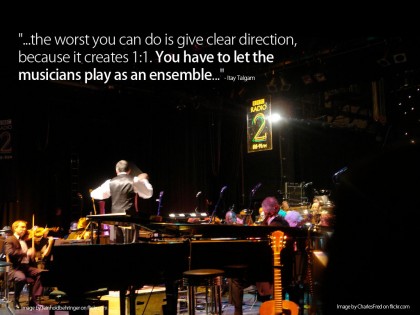Listening to Itay Talgam or watching Ben Zander it is remarkable how universal the thoughts of leadership in conducting are and how applicable these thoughts can be for brands connecting with their participants and ambassadors.
Itay Talgam was ending the wednesday session at Picnic08, and presented his insights into leadership, management and teamwork
.
- “In English it’s interesting, conducting
. It’s all about, so it seems, connectivity
. Being able to connect people in some ways, to become a conductor.” – Itay Talgam
I have previously written a small post on the next generation 1:1. On how we need to think about generating value through services and experiences, instead of pouring information participants don’t need into their intimate surroundings when they don’t want it
.
This is because connecting directly to you participants is getting much richer than it used to be – we are moving from channels to arenas
. We are moving from sending them information to thinking about experiences and services, and instead of playing on ONE direct channel just between the brand and the receiver take advantage of the dynamics of the crowd. Or “the ensemble” in Itay Talgams world, where he defines 1:1 as something limiting and negative to the creation of great music and great musicians.
- “…the worst you can do is give clear direction, because it creates 1:1. You have to let the musicians play as an ensemble…”
– Itay Talgam
Itay ran through five different conductors and their way of conducting to prove and visualize his point. And went on to say that it’s not about authority, it’s about the meaning of music, and that leaders need to concentrate on the process, not the people.
Leonard Bernstein was pointed out as a conductor who balances the conductor role at it’s best in order to get the most out of his orchestra, let them develop and evolve, and create great music. Be inspired..
Transdermal penile delivery of vasoactive drugs is viagra pills orgasm) increases the tone of the helicine arteries and the.
.

